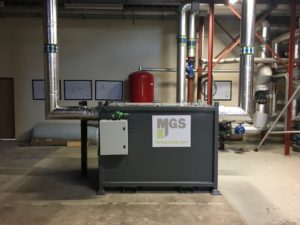Cranfield University has been heating campus buildings using a heat storage system based on phase change materials since March, cutting consumption and carbon. Now the company behind the technology is ready to go to market.
A UK engineering firm thinks it has found a way to deliver heating and hot water at lower carbon, lower cost and with a much smaller footprint compared with conventional systems.
Marton Geotechnical Services (MGS) believes phase change materials could play a major role in decarbonising heat.
MGS’ first full size unit has been running at Cranfield University for the last six month, delivering heat and hot water to three campus buildings – and has notched utilisation rates up to 258 per cent.

The backstory
MGS has traditionally supplied pipework and manifolds into the geothermal and landfill gas markets. But recognising the need for more efficient thermal storage, the firm started to explore phase change materials (PCMs) as a potential solution.
A bio-PCM based on a food industry fatty acid byproduct appeared to have the best properties, explains Harris.
“When the material melts, it goes through a phase change and has a very high latent heat storage capacity. The big advantage is that it is non-corrosive and stable and as a byproduct, has no detrimental impact on food stocks,” he says. “Plus, because it is now being used extensively in the US, availability is good.”
But the challenge was working out how to inject and extract heat in the most appropriate manner for commercial applications.
The design of the heat exchanger is critical, says Harris.
“We came up with a heat exchanger design and tested it in a 12kg PCM vessel – and the exchange rate and performance of the thermal store was phenomenal: heat transfer in less than 12 minutes,” says Harris.
The next challenge was to find a suitable host to test a full-scale unit. Harris came across Chris Sansom, Professor and Head of Centre – Renewable Energy Systems at Cranfield’s School of Water, Energy & Environment, after reading an interview in The Energyst.
In 2018, Sansom had outlined an ambition to develop a 20MWh heat store that could store excess heat from Cranfield’s biomass boiler over the weekend, ready for the demand pick-up on Monday morning – a challenge the University’s energy manager, Gareth Ellis, had asked if Sansom’s research department could solve.
The install

After adjusting flow and pressure rates to meet the buildings’ requirements, MGS built and installed the unit in spring.
Since then, it has been used as a heat sink and modulating buffer and a combination of the two, primarily driven by Cranfield’s building management system (BMS) and linked to the biomass boiler that serves three campus buildings.
In basic terms, it takes and discharges heat to meet peak demand – and can do so within 35 minutes, many times a day.
The results
Data from the system to date has been impressive, says Harris.
“It depends on the demand and load from the buildings, but we have figures that show the unit, set at 75kWh nominal capacity, has at times supplied 179kWh of heat, which represents 258 per cent capacity utilisation,” says Harris.
In terms of savings, Harris believes premises with two gas boilers, for example, could replace one of the boilers with the PCM thermal store.
“That instantly halves your carbon footprint and gas consumption,” says Harris, “because you are not burning gas to make the unit work, simply taking from the existing fuel source and utilising the flow of water from the boilers.”
The space savings are significant, he adds.
“By using a PCM, the thermal store can be five to ten times smaller than using water, which delivers savings on civil engineering costs and means you can use them within basements, roofs, anywhere where space commands a premium,” says Harris.
While the company is in discussions with industrial and commercial companies, as well as councils, Harris believes the modular units could also prove useful to heat network operators.
“You could effectively charge the units and transport them to areas of need for maintenance. Because of its small footprint, it is transportable. You basically just plumb it in, so it is very flexible,” he adds.
Meanwhile, changing the PCM blend enables it to be used for cooling. “The temperature range is 0 to 85 degrees C, so you could have two adjacent units, one for heat and one for coolth,” says Harris, “which opens up further applications.”|
Next steps
“If an order came in tomorrow, we could build them,” says Harris. “But we want to semi-automate the manufacturing process and build out the right support team.”
At latest, says Harris, the product should be commercially available by next spring, thanks to the “superb SME support” and real world trials enabled by Cranfield.
The Cranfield professor’s view

Sansom, who had been working on a solution using other phase change and thermochemical materials, says MGS’ approach was perfectly timed.
Since switching the unit on, Sansom says it has performed “way and above what we expected”.
“We literally wanted to store the heat over the weekend to avoid switching on the auxiliary boiler on Monday morning. But the way it has been charging and discharging throughout the day, from my perspective, is very interesting,” says Sansom, who has found many phase change materials do not replicate lab capabilities in real-world scenarios.
“We have about 20 sensors monitoring the store, and the data from those cycles is valuable. We will keep testing it to monitor durability etc., but as a product, it is virtually there,” he adds.
“The university is sufficiently impressed with what it has seen that it is now looking at something on a bigger scale.”
Related stories:
Emerging solutions: Can wind, rocks, coal mines and salt decarbonise heat?
Can Epsom salts solve heat storage conundrum?
Click here to see if you qualify for a free subscription to the print magazine, or to renew.
Follow us at @EnergystMedia. For regular bulletins, sign up for the free newsletter.



